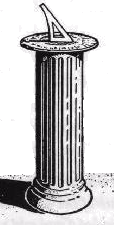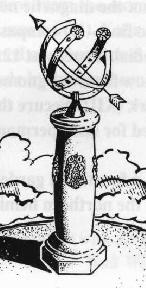The (Y2K Compliant) Sundial
Jack Kramer
"A dial is the visible map of time, till whose invention 'twas follie in the Sun to play with a shadow. It is the anatomie of the day and a scale of miles for the Jornie of the Sun."
- Robert Hegge, 1630

It seems there is a constant flood of new discoveries about the sun that is a product of the sophisticated instrumentation now in the hands of astronomers. But contrast this with the long distant past, when mankind simply observed the sun for a very utilitarian purpose. Time was measured based on the shadow cast by the sun as it traced its path across the sky. Perhaps it started by someone watching the shadow cast by a tree or stick in the ground. Eventually this evolved into the very first astronomical instrument - the sundial. I suppose it's inevitable that there should be a technical-sounding word for this; it's called "gnomonics" - the measurement of time by the sun's shadow. This term originates from the word "gnomon", which refers to the stick, pylon, tree, or whatever is used to cast a shadow. Gnomons are oriented toward the North Pole in the Northern Hemisphere; the morning shadow falls to the left of the gnomon, while in the afternoon, it falls to the right.
The earliest known written mention of a sundial is in the Bible. In Isaiah 38:8 it is written "Behold I will bring again the shadow of the degree, which is gone down in the sundial of Ahaz, ten degrees backward." The earliest intact sundial is an Egyptian shadow clock which dates from 800 BC. It's a straight bar with a T-shaped crosspiece attached at one end on a 90o angle. The bar, which was placed in the east-west position, is inscribed with six divisions to measure the shadow of the crosspiece. It had to be reversed at noon each day so the bar of the T was facing the sun. Around 300 BC, the Babylonians developed a hemispheric sundial, which according to the Arab astronomer Al-Battani, was still in use in Muslim countries during the 10th Century. Other refinements included the Romans' invention of a portable sundial that allowed seasonal and latitudinal adjustments.
Although sundials of elaborate design were produced during the Renaissance, the invention of the clock signaled the end of sundials as the common method of telling time. However, European clockmakers sometimes sent small sundials with their clocks to the American colonies to ensure that the clocks were set properly. And in Europe, there were sundials installed on clock towers to verify the accuracy of the clockwork.
Sundials indicate apparent solar time, while clocks are regulated to indicate mean solar time. Because of the fixed time zones that were adopted in the 19th Century, there are only four days a year when a sundial and clock will agree: April 1, June 15, September 1, and December 24. On the other days, a clock will be faster or slower than a sundial by an amount referred to as the "equation of time". The greatest difference in time (16 minutes) occurs in November. Some world globes include an analemma, which is a narrow figure-eight-shaped diagram that plots the equation of time for an entire year.
Another form of sundial uses a metal sphere into which is projected the shadow of the sun. This type is somewhat easier to read with accuracy than the horizontal kind. This is sometimes mistakenly referred to as an "armillary sphere". Although there is a resemblance, the two are not the same. An armillary sphere is a medieval device used to show the important celestial meridians and equators. The gnomon of the spherical sundial is often in the form of an arrow, which is aimed toward the North Celestial Pole (not the magnetic pole). This means the gnomon should point to the North Star. To adjust a sundial, it's quite acceptable to simply check your watch, then at noon set the sundial so the shadow falls exactly on the noon mark. If you insist on precision, you'll do this on one of the four days when clock time matches the apparent solar time.

Today sundials serve as quaint reminders of past centuries that are relegated to gardens and public plazas. They remind us too that it is the motion of our planet that ultimately measures the hours, minutes, and seconds of our lives. Once in awhile, someone comes up with a really novel or "up-to-date" sundial. Whatever their form, to quote the poet Bernard Barton, sundials are "...simple, silent, and sublime". They're also Y2K compliant!





